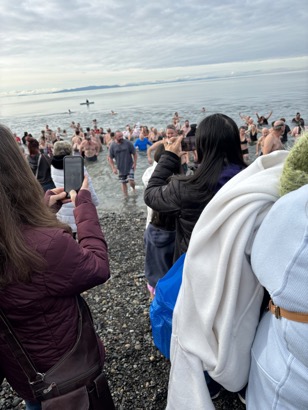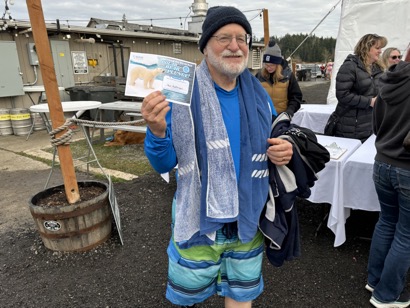Plunge
02/01/24 01:28
I have lived all of my life as a part of congregations that are a part of the Congregational-Christian side of the United Church of Christ. One of the quirks of our particular history and corner of Christianity is that the union of the National Council fo the Congregational Churches in the United States and the General Convention of the Christian Church during an historic meeting in Seattle, Washington in 1931 brought together to denominations with similar ways of governing themselves but different theologies and understandings of church practice. Among the differences is that one denomination predominantly practiced the baptism of infants by sprinkling and the other predominantly practiced baptism by immersion of older children, sometimes called believer’s baptism.
All of that happened before I was born, so I grew up in a church that officially respected both forms of baptism. We officially honor and affirm baptism of infants and also baptism of children when they reach the age of making their own decisions. We officially affirm baptism by sprinkling, pouring, and by immersion. The one thing that has given us pause when it comes to baptism is the practice of re-baptizing someone who has previously been baptized. We simply do not see the need of repeating the sacrament. If baptism is truly a sacrament, that is a moment of direct encounter with God’s sacredness, then it cannot be manipulated by a human being. It is not for us as humans to judge baptisms performed by others. One of the expressions of that is that I believe and have practiced as a minister the belief that I do not possess the authority to refuse a sacrament, whether it be baptism or holy communion, to anyone. When I officiated at sacraments, I tried to always be clear that anyone who chose to come for the sacrament was welcome, without exceptions.
I have officiated at baptisms of infants and baptisms of older persons. I have officiated at baptisms by sprinkling and baptisms by pouring and baptisms by full immersion. I have officiated at baptisms in sanctuaries with special fonts, in sanctuaries with baptismal pools, in homes and hospitals with a small portable basin, in lakes and rivers and in public swimming pools. I have witnessed baptisms in fountains. I have experienced each of these as sacred moments.
I was baptized as an infant in the first year of my life. I do not remember the ceremony, though I can remember the baptisms of my younger brothers. Nonetheless, I believe that I was fully welcomed into the body of the Christ known as the church at my baptism. I displayed my baptismal certificate, signed by Rev. E. Brentwood Barker, on the wall of my office along with my diplomas, my certificate of ordination, and my certification as a Christian educator.
 However, even though I was baptized by sprinkling as an infant, and even though I do not see any reason to repeat that sacrament, I did, yesterday, take the step of full immersion. That’s right, I waded into the Salish Sea until I reached a place where it was about up to my waist in depth and dove fully under the water. The ritual was not particularly religious, however. It was part of a secular tradition that has been practiced in our little bay for 44 years of a New Years Day Polar Plunge. Precisely at noon on New Year’s Day, a time designated for a test of the area’s tsunami warning sirens, hundreds of people wade into the water and dive under for a few seconds. A few remain and swim a few strokes. Most exit rather quickly, towel off and head for a warming tent to put on warm clothes.
However, even though I was baptized by sprinkling as an infant, and even though I do not see any reason to repeat that sacrament, I did, yesterday, take the step of full immersion. That’s right, I waded into the Salish Sea until I reached a place where it was about up to my waist in depth and dove fully under the water. The ritual was not particularly religious, however. It was part of a secular tradition that has been practiced in our little bay for 44 years of a New Years Day Polar Plunge. Precisely at noon on New Year’s Day, a time designated for a test of the area’s tsunami warning sirens, hundreds of people wade into the water and dive under for a few seconds. A few remain and swim a few strokes. Most exit rather quickly, towel off and head for a warming tent to put on warm clothes.
Yesterday was sunny at noon here and when I emerged from the water and dried off with my towel, I was sufficiently warmer than I had been while immersed that I picked up my certificate and walked with my wife, who served as my support person, holding my outer clothing and glasses as I stripped to my swimsuit and waded into the ocean, to our car. We waited patiently in the heavy traffic departing the parking lot, got onto the street, and drove to our house where I promptly took a warm shower. With the salt water rinsed off, and my body warmed up, I proudly wore my commemorative polar plunge t shirt the rest of the day. I’m likely to wear it fairly frequently in the years to come. In polar plunge tradition, it is long-sleeved and quite nice for chilly weather.
 I rather like this somewhat quirky tradition of my adopted home even though I did not participate in previous years. The year we moved to the community, I only learned about the plunge at the last minute and it snowed on New Years Day that year. I stayed home and enjoyed a big dinner with my family. The next year, we were traveling and were at our daughter’s home in South Carolina on New Year’s Day. But this year, we were home and I planned for several weeks in advance to take the plunge. I announced my plans to my family to bolster my courage, though I confess the practice didn’t require much courage at all. It was a fun lark for a laid back day. Our family celebrations also included a round of mini-golf with grandchildren, a walk on the beach and another walk in the park, a few games and snacks and a family dinner around the table in our dining room. It was a good day and, I think might be the start of a new tradition. I told our grandchildren that they would be welcome to join me next year, though none of them seemed inclined to do so. I also told them that I thought I should do it each year at least until I am eighty. If so, I could collect eleven t-shirts. I don’t happen to need any more t-shirts. I’ve collected sets from National Youth Events, from Survivors of Suicide Awareness Walks, from Habitat for Humanity home builds, and many other occasions and events.
I rather like this somewhat quirky tradition of my adopted home even though I did not participate in previous years. The year we moved to the community, I only learned about the plunge at the last minute and it snowed on New Years Day that year. I stayed home and enjoyed a big dinner with my family. The next year, we were traveling and were at our daughter’s home in South Carolina on New Year’s Day. But this year, we were home and I planned for several weeks in advance to take the plunge. I announced my plans to my family to bolster my courage, though I confess the practice didn’t require much courage at all. It was a fun lark for a laid back day. Our family celebrations also included a round of mini-golf with grandchildren, a walk on the beach and another walk in the park, a few games and snacks and a family dinner around the table in our dining room. It was a good day and, I think might be the start of a new tradition. I told our grandchildren that they would be welcome to join me next year, though none of them seemed inclined to do so. I also told them that I thought I should do it each year at least until I am eighty. If so, I could collect eleven t-shirts. I don’t happen to need any more t-shirts. I’ve collected sets from National Youth Events, from Survivors of Suicide Awareness Walks, from Habitat for Humanity home builds, and many other occasions and events.
I do, however, intend to repeat the experience. The cold salty water makes one aware of being fully alive, which is a good experience at any age.
All of that happened before I was born, so I grew up in a church that officially respected both forms of baptism. We officially honor and affirm baptism of infants and also baptism of children when they reach the age of making their own decisions. We officially affirm baptism by sprinkling, pouring, and by immersion. The one thing that has given us pause when it comes to baptism is the practice of re-baptizing someone who has previously been baptized. We simply do not see the need of repeating the sacrament. If baptism is truly a sacrament, that is a moment of direct encounter with God’s sacredness, then it cannot be manipulated by a human being. It is not for us as humans to judge baptisms performed by others. One of the expressions of that is that I believe and have practiced as a minister the belief that I do not possess the authority to refuse a sacrament, whether it be baptism or holy communion, to anyone. When I officiated at sacraments, I tried to always be clear that anyone who chose to come for the sacrament was welcome, without exceptions.
I have officiated at baptisms of infants and baptisms of older persons. I have officiated at baptisms by sprinkling and baptisms by pouring and baptisms by full immersion. I have officiated at baptisms in sanctuaries with special fonts, in sanctuaries with baptismal pools, in homes and hospitals with a small portable basin, in lakes and rivers and in public swimming pools. I have witnessed baptisms in fountains. I have experienced each of these as sacred moments.
I was baptized as an infant in the first year of my life. I do not remember the ceremony, though I can remember the baptisms of my younger brothers. Nonetheless, I believe that I was fully welcomed into the body of the Christ known as the church at my baptism. I displayed my baptismal certificate, signed by Rev. E. Brentwood Barker, on the wall of my office along with my diplomas, my certificate of ordination, and my certification as a Christian educator.

Yesterday was sunny at noon here and when I emerged from the water and dried off with my towel, I was sufficiently warmer than I had been while immersed that I picked up my certificate and walked with my wife, who served as my support person, holding my outer clothing and glasses as I stripped to my swimsuit and waded into the ocean, to our car. We waited patiently in the heavy traffic departing the parking lot, got onto the street, and drove to our house where I promptly took a warm shower. With the salt water rinsed off, and my body warmed up, I proudly wore my commemorative polar plunge t shirt the rest of the day. I’m likely to wear it fairly frequently in the years to come. In polar plunge tradition, it is long-sleeved and quite nice for chilly weather.

I do, however, intend to repeat the experience. The cold salty water makes one aware of being fully alive, which is a good experience at any age.
